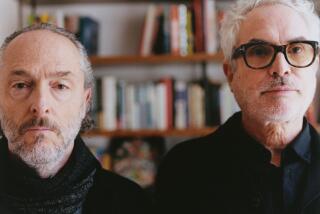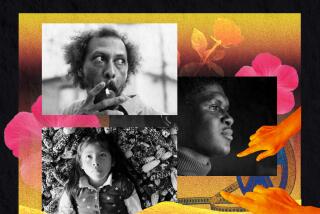Oscars 2014: ‘Gravity’s’ pull on director, cinematographer
Anyone who has seen director Alfonso Cuarón and cinematographer Emmanuel Lubezki work together might think they spend all of their time arguing like an old married couple, the squabbles punctuated by all manner of Spanish swear words.
“They are very intense,” said David Heyman, a producer of “Gravity,” their Oscar-nominated and most celebrated collaboration. “They are both perfectionists and unrelenting in their pursuit of that perfection.”
But like some old married couples, underneath their disagreements rest a deep and abiding trust and respect.
Friends from their Mexican childhood — “We went to parties together as teens,” Cuarón said — Lubezki and Cuarón collaborated on five previous features: “Love in the Time of Hysteria,” “A Little Princess,” “Great Expectations,” “Y Tu Mamá También” and “Children of Men.”
“It’s like we’re on the same frequency. Things happen naturally,” Lubezki said of working with Cuarón. Both are favorites to win Oscars on Sunday night.
Cuarón, 52, calls the 49-year-old Lubezki his “co-director,” a professional relationship dramatized by how one of “Gravity’s” signature scenes came together — Sandra Bullock’s slowly rotating in her underwear inside a Russian space capsule as if she were a baby in a womb.
As first pictured by Cuarón and even photographed by Lubezki, the scene had an almost engineered look, Bullock lit by the harsh fluorescent lights in the capsule. “He wanted the feeling of the scene to be totally different — much more industrial,” Lubezki said. But the cinematographer thought Cuarón’s approach was a little misguided, and went off with visual effects supervisor Tim Webber to rework the sequence.
Thanks to the power of visual effects, Lubezki over the course of several weeks was able to add a window in the capsule door, thus redirecting the light source away from inside the cabin to outside it, so that Bullock was lit not by bulbs but by the sun, its light pouring through the porthole and framing her as if she were being reborn.
When Lubezki took his version to Cuarón, he was not optimistic. “My guess is you’re not going to like it,” Lubezki told the director. But Cuarón, knowing a great shot when he saw it, promptly ditched his own interpretation of the scene.
“He said we needed a glimpse of nature and he was right,” Cuarón said. “He understands the difference between the conceptual and the emotional. Because sometimes I get carried away with the conceptual.”
Small choices like that often separate a great work of art from the mediocre masses, and Lubezki’s attention to detail is not limited to his collaborations with Cuarón.
Earlier this week in Anza Borrego Desert State Park, Lubezki was working as the cinematographer on the low-budget independent film “Last Days in the Desert,” where time was fleeting and a creative solution essential.
Because the biblical allegory from writer-director Rodrigo Garcia, due out later this year, unfolds a few decades after Jesus’ birth, it was critical that no modern references intruded into the frame. So Lubezki flipped open a pocket knife, knelt in the sand and sawed off swatches of muslin from some set dressing. With gaffer’s tape, he wrapped the fabric around the waffle-soled hiking shoes of Steadicam operator Colin Anderson, so that Anderson’s footprints wouldn’t contaminate the image.
PHOTOS: On the set of ‘Gravity’
Lubezki now divides his time among a small handful of filmmakers: Cuarón, Garcia, Alejandro González Iñárritu (Lubezki just shot his “Birdman,” due later this year) and Terrence Malick. Lubezki, known as “Chivo” (Spanish for goat) to everybody he works with, was the cinematographer for Malick’s “Tree of Life” and “To the Wonder.” He also shot the director’s upcoming “Knight of Cups” and another untitled Malick film.
“I try to listen to and understand what the director is trying to do,” Lubezki said. “How they want to shoot the movie and express the emotions.”
Yet the cinematographer’s closest working relationship is not with a camera or a lens but with fellow Mexican-born filmmaker Cuarón, with whom Lubezki conjured up “Gravity” even as everyone told them the movie was impossible.
While most media attention has focused on Cuarón’s membership in Cha Cha Cha, a production company composed of the “three amigos” of Mexican directors Guillermo del Toro (“Pacific Rim”) and Iñárritu (“Babel”), his relationship with Lubezki has been far more fruitful.
Cuarón was unable to hire Lubezki to shoot just one of his movies, “Harry Potter and the Prisoner of Azkaban,” because the cinematographer already was set to film “Lemony Snicket’s A Series of Unfortunate Events” for director Brad Silberling. Even then, Lubezki worked with Cuarón to find a replacement, recommending Michael Seresin to fill his shoes.
PHOTOS: Movie scenes from ‘Gravity’
“He elevates everything I do,” Cuarón said. “We have a very similar eye. And we have a very similar curiosity about film language, and we are trying to explore all of the possibilities of that language.”
Undoubtedly the most celebrated Lubezki-Cuarón collaboration so far is “Gravity,” their riveting tale of two astronauts (Bullock and George Clooney) trying to survive a catastrophic space accident that has left them hurtling across the heavens. From “Gravity’s” inception, Cuarón was determined to fuse Lubezki’s profound understanding of light with the director’s determination to create naturalistic visual effects, all while employing the same multi-minute takes that distinguished “Children of Men.”
For more than a year before principal photography commenced, Lubezki, Cuarón and Webber (a lock to win the Oscar in his category) labored to figure out how to film the two actors as if “Gravity” actually was shot on location beyond Earth’s atmosphere and gravitational pull. Their breakthrough solution was a roughly 20-foot-tall, 10-foot-wide cube filled with LED lights. In it, robotic rigs moved cameras and performers in an elaborately choreographed dance, yielding the illusion of weightlessness combined with lifelike illumination from the sun and stars.
No matter how inventive the filmmaking technology, “Gravity,” co-written by Cuarón and his son, Jonás, would be soulless unless Lubezki photographed Bullock and Clooney as if they were living, breathing, relatable people.
“Rarely can you see visual effects films where there is a seamless integration of light. The goal is naturalism, not a fantasy, comic-book approach,” Cuarón said. “From our very first movie together, we’ve always tried to honor available light.”
TIMELINE: Grammy Awards through the years
Lubezki said he was motivated to film “Last Days in the Desert” because he always wanted to shoot in an arid region. “I’ve never done a western, and this to me is a biblical western,” Lubezki said.
But the cinematographer, who has yet to direct his own feature but may do so in the future, also seemed relieved to be freed from deep space, complex lighting designs and extended takes. By his math the lowest-budget movie he’s ever shot, “Last Days in the Desert” will be filmed in just 24 days, a fraction of the time of his other features. The only real tool at his disposal in Anza Borrego was the often-unrelenting sun and the way he oriented his cameras to it.
“It’s not a documentary, but it’s the equivalent equipment,” he said soon after he finished wrapping his Steadicam operator’s shoes. “It’s a big relief. It’s just fun.”
More to Read
Only good movies
Get the Indie Focus newsletter, Mark Olsen's weekly guide to the world of cinema.
You may occasionally receive promotional content from the Los Angeles Times.











